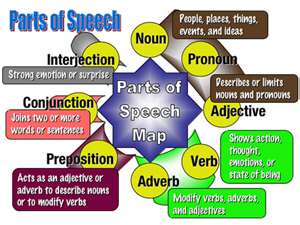
SPC-ELL: Identifying Parts of Speech
Self-Paced Collection of English Language Lessons
You must "Allow Blocked Content" on your computer to complete this SoftChalk Lesson. If you have trouble with the video, audio, or activities, try a different browser. Make sure yu have Java and Adobe Flash enabled an dupdated.
Let's begin. Click on the arrow to watch the video. Then, go to the next page.
Click play and read along.
In the video, you heard these words as examples of the different parts of speech.
1. Verbs - have, help, do, run, walk, play, sing
2. Noun - girl, man, table, car
3. Adjectives - good, bad, red, blue, exciting
4. Adverbs - fast, quickly, very, beautifully
5. Pronouns - I, he, him, her, we
6. Prepositions - after, on, at, to
7. Conjunctions - and, but, when
8. Interjections - ouch, hi, well
Check your understanding: Try the Drag N Drop Activity to practice identifying the different parts of speech. (Interjections are not included in this activity.)
Click play and read along.
Verbs are words that show action, condition, or state. Every sentence must have a verb.
|
Types of Verbs: |
Action Verbs |
Linking Verbs |
Auxiliary Verbs |
|---|---|---|---|
|
Examples: |
work, study, eat, copy, read, play, drive, evaluate, examine, determine, analyze |
appear, become, feel, get, look, seem, smell, stay, taste, be |
be, do, have, can, could, should, must, may, would, will, etc. (all modals) |
Example sentences:
Check your understanding: Try this "Quiz" Activity to practice identifying verbs in sentences. Remember, some verbs consist of more than one word.

Click play and read along.
Nouns are words for people, places, things, or ideas.
|
Singular |
Plural |
Non-Count |
|---|---|---|
|
boy, dog, man, school, neighborhood, mouse, box, baby, tooth |
boys, dogs, men, schools, neighborhoods, mice, boxes, babies, teeth |
water, class, audience, team, coffee, sugar, furniture, jewelry, junk, news, tennis, rice, hair, homework, collection |
Nouns are often the subject of a sentence; however, they can also function as a direct or indirect object.
Example sentences:
Check your understanding: Try this "Quiz" Activity to practice identifying subjects and objects in a sentence.

Click play and read along.
Adjectives are words that describe a noun or a pronoun.
Example Sentences:
Check your understanding: Practice identifying adjectives. There are 8 adjectives in the following short paragraph. Can you find them? After you read the paragraph, click on the "Sorting Activity."
|
Behind my childhood home, there is a large piece of land that is surrounded by banana trees. Their green leaves are so thick that sunlight cannot pass through. During the rainy season, the garden produces a very strange melody when the raindrops fall on the leaves. Now, whenever I hear raindrops on the roof of my apartment in the city, I remember the beautiful garden of my childhood.
(Adapted from Introduction to Academic Writing, Third Edition. Oshima & Hogue, 2007) |
Adjectives have two possible locations in an English sentence:
Check your understanding: Try this "Quiz" Activity to practice putting adjectives in the correct place in a sentence.

Click play and read along.
Adverbs are words that describe verbs, adjectives, or another adverb.
Example Sentences:
Notice that adverbs can be located in different places in English sentences:
Check your understanding: Try this "Quiz" Activity to practice identifying adverbs in sentences.

Click play and read along.
Pronouns are words that replace nouns.
|
Type of Pronoun: |
Subject Pronoun |
Object Pronoun |
Possessive Pronoun |
|---|---|---|---|
|
Singular |
I You He, she it |
Me You Him, her, it |
Mine Yours His, hers, its |
|
Plural |
We You They |
Us You Them |
Ours Yours Theirs |
Example sentences:
Check your understanding: Try this "Labeling" Activity to practice with prounouns.
Prepositions are words that show relationships between nouns and the rest of the sentence. They give us information about time, location, or direction.
Watch the video to learn about prepositions.
Click play and read along.
My job is very stressful and difficult. I need a vacation! I want to go on a long vacation next month, but I can only take four days off. I'm thinking about going to New York or Miami. If I go to New York, I would need an expensive plane ticket, so I think I'll go to Miami instead. I can drive there, so it would be cheaper. I'll just take I-4 across Florida, and then drive down the east coast toward Miami. I won't even bring my cell phone or computer on my vacation. I'm very excited!
Conjunctions connect words, phrases, or clauses. There are three types of conjunctions in English: coordinating conjunctions, subordinating conjunctions, and correlative conjunctions. Watch this video to learn more.
Click play and read along. Notice how conjunctions are used in this paragraph to join words, phrases, and clauses.
My job is very stressful and difficult. I need a vacation! I want to go on a long vacation next month, but I can only take four days off. I'm thinking about going to New York or Miami. If I go to New York, I would need an expensive plane ticket, so I think I'll go to Miami instead. I can drive there, so it would be cheaper. I'll just take I-4 across Florida, and then drive down the east coast toward Miami. I won't even bring my cell phone or computer on my vacation. I'm very excited!
Check your understanding. Try this "Sorting" Activity to see how many parts of speech you can correctly identify.